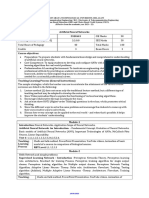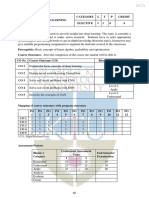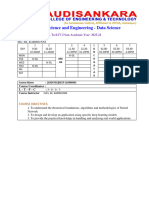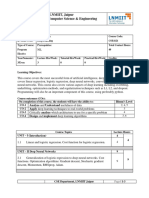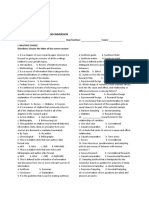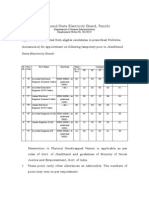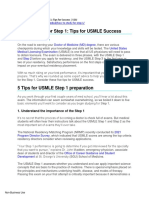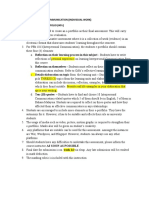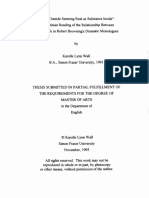Semester- IV
Deep Learning
Course Code 22MCA411 CIE Marks 50
Teaching Hours/Week (L:P:SDA) 2:0:0:2 SEE Marks 50
Total Hours of Pedagogy 40 Total Marks 100
Credits 03 Exam Hours 03
Course Learning objectives:
Demonstrate the basics of deep learning for a given context.
Implement various deep learning models for the given problem
Realign high dimensional data using reduction techniques for the given problem
Analyze optimization and generalization techniques of deep learning for the given problem.
5. Evaluate the given deep learning application and enhance by applying latest techniques
Module-1
Introduction to machine learning- Linear models (SVMs and Perceptron’s, logistic regression)- Intro to Neural
Nets: What a shallow network computes- Training a network: loss functions, back propagation and stochastic
gradient descent- Neural networks as universal function approximates
Teaching- Chalk and Talk/PPT/Web Content
Learning
Process
Module-2
DEEP NETWORKS : History of Deep Learning- A Probabilistic Theory of Deep Learning- Back propagation and
regularization, batch normalization- VC Dimension and Neural Nets-Deep Vs Shallow Networks Convolutional
Networks- Generative Adversarial Networks (GAN), Semi- supervised Learning
Teaching- Chalk and Talk/PPT/Web Content
Learning
Process
Module-3
DIMENTIONALITY REDUCTION : Linear (PCA, LDA) and manifolds, metric learning - Auto encoders
and dimensionality reduction in networks - Introduction to Convnet - Architectures – AlexNet, VGG,
Inception, ResNet - Training a Convnet: weights initialization, batch normalization, hyper parameter
optimization
Teaching- Chalk and Talk/PPT/Web Content
Learning
Process
Module-4
OPTIMIZATION AND GENERALIZATION Optimization in deep learning– Non-convex optimization for
deep networks- Stochastic Optimization Generalization in neural networks- Spatial Transformer
Networks- Recurrent networks, LSTM - Recurrent Neural Network Language Models- Word-Level RNNs
& Deep Reinforcement Learning - Computational & Artificial Neuroscience
Teaching- Chalk and Talk/PPT/Web Content
Learning
Process
Module-5
CASE STUDY AND APPLICATIONS Imagenet- Detection-Audio Wave Net-Natural Language Processing
Word2Vec - Joint Detection Bio Informatics- Face Recognition- Scene Understanding- Gathering Image
Captions
Teaching- Chalk and Talk/PPT/Web Content
Learning
Process
@#01112023
@#25102023 47
� Assessment Details (both CIE and SEE)
The weightage of Continuous Internal Evaluation (CIE) is 50% and for Semester End Exam (SEE) is 50%. The
minimum passing mark for the CIE is 50% of the maximum marks. Minimum passing marks in SEE is 40% of the
maximum marks of SEE. A student shall be deemed to have satisfied the academic requirements and earned the
credits allotted to each subject/ course if the student secures not less than 50% (50 marks out of 100) in the sum
total of the CIE (Continuous Internal Evaluation) and SEE (Semester End Examination) taken together.
Continuous Internal Evaluation:
Three Unit Tests each of 20 Marks
Two assignments each of 20 Marks or one Skill Development Activity of 40 marks
to attain the COs and POs
The sum of three tests, two assignments/skill Development Activities, will be scaled down to 50 marks
CIE methods /question paper is designed to attain the different levels of Bloom’s taxonomy as per the
outcome defined for the course.
Semester End Examination:
The SEE question paper will be set for 100 marks and the marks scored will be proportionately reduced to 50.
The question paper will have ten full questions carrying equal marks.
Each full question is for 20 marks. There will be two full questions (with a maximum of four sub-questions)
from each module.
Each full question will have a sub-question covering all the topics under a module.
The students will have to answer five full questions, selecting one full question from each module
.Suggested Learning Resources:
Books
1. Cosma Rohilla Shalizi, Advanced Data Analysis from an Elementary Point of View,2015.
Reference Books
Deng & Yu, Deep Learning: Methods and Applications, Now Publishers, 2013.
Ian Good fellow, Yoshua Bengio, Aaron Courville, Deep Learning, MIT Press, 2016.
3. Michael Nielsen, Neural Networks and Deep Learning, Determination Press, 2015.
Web links and Video Lectures (e-Resources):
Skill Development Activity
The students with the help of the course teacher can take up relevant technical –activities which will enhance their
skill. The prepared report shall be evaluated for CIE marks.
Course outcome (Course Skill Set)
At the end of the course the student will be able to :
Sl. No. Description Blooms Level
CO1 Illustrate the basics of deep learning for a given context L2
CO2 Apply various deep learning models for the given problem L3
CO3 Realign high dimensional data using reduction techniques for the given problem L2
CO4 Apply and Analyze optimization and generalization techniques for the given problem L2
CO5 Application of latest deep learning techniques and to enhance the results.. L3
@#01112023
@#25102023 48
� Mapping of COS and POs
PO1 PO2 PO3 PO4 PO5 PO6 PO7 PO8 PO9 PO10 PO11 PO12
CO1
CO2
CO3 X X X X
CO4
CO5 X X X
@#01112023
@#25102023 49


















